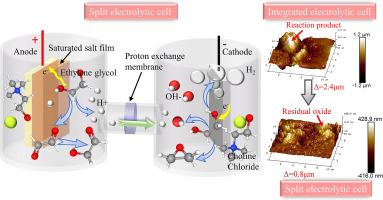Enhancing the anodic dissolution uniformity of dendritic-structured refractory high entropy alloys using a split electrolytic cell with a deep eutectic solvent
IF 5.3
2区 材料科学
Q1 MATERIALS SCIENCE, COATINGS & FILMS
引用次数: 0
Abstract
The attainment of uniform anodic dissolution in dendritic-structured refractory high entropy alloys (RHEAs) during the electropolishing process is essential for their utilization in high-precision components. Nevertheless, the intricate microstructures of these materials impede uniform dissolution, resulting in suboptimal surface quality. In this work, based on a choline chloride-based deep eutectic solvent and suitable polarization parameters selected by linear scanning voltammetry, a split electrolytic cell (SEC) was proposed to alter the traditional integrated electrolytic cell (IEC) to enhance the anodic dissolution uniformity of dendritic-structured RHEAs. A much smoother surface with Ra of 0.233 μm and a smaller height discrepancy of 0.8 μm was obtained, compared to those processed in IEC at the same condition. The non-uniform anodic dissolution was mainly attributed to the cathode-forming (hydroxide ion (OH−), dissolution of tungsten (W) in the dendrite region under the attack by OH−, and the formation of by-product, i.e., the water molecule. The positive impact of SEC on dissolution uniformity could be ascribed to its role in inhibiting OH− from interacting with the anode, as well as to the enhancement of solution acidity on the anode side, which facilitated the dissolution of metal oxides. The suggested reaction pathway was subsequently validated through experiments with controlled water concentration and assessing of electrochemical kinetics. Finally, the effects of SEC under different parameters were demonstrated. This work provides valuable insight into the precise, micro/nanoscale manufacturing and green electrochemical surface finishing of RHEAs in the future.

使用带有深共晶溶剂的分离式电解槽提高树枝状结构难熔高熵合金的阳极溶解均匀性
在电抛光过程中,在树枝状结构的难熔高熵合金(RHEAs)中实现均匀的阳极溶解对其在高精度部件中的应用至关重要。然而,这些材料错综复杂的微观结构阻碍了均匀溶解,导致表面质量不理想。在这项工作中,基于氯化胆碱基深共晶溶剂和通过线性扫描伏安法选择的合适极化参数,提出了一种分体式电解槽(SEC)来改变传统的集成电解槽(IEC),以提高树枝状结构 RHEA 的阳极溶解均匀性。与相同条件下在 IEC 中处理的 RHEA 相比,SEC 得到了更光滑的表面(Ra 为 0.233 μm)和更小的高度差(0.8 μm)。阳极溶解不均匀的主要原因是阴极形成氢氧根离子(OH-)、枝晶区的钨(W)在 OH- 的侵蚀下溶解以及副产物(即水分子)的形成。SEC 对溶解均匀性的积极影响可归因于其抑制 OH- 与阳极相互作用的作用,以及阳极一侧溶液酸度的增强,这有利于金属氧化物的溶解。随后,通过控制水浓度和评估电化学动力学实验验证了所提出的反应途径。最后,证明了不同参数下 SEC 的效果。这项工作为未来 RHEA 的精确、微/纳米级制造和绿色电化学表面处理提供了宝贵的见解。
本文章由计算机程序翻译,如有差异,请以英文原文为准。
求助全文
约1分钟内获得全文
求助全文
来源期刊

Surface & Coatings Technology
工程技术-材料科学:膜
CiteScore
10.00
自引率
11.10%
发文量
921
审稿时长
19 days
期刊介绍:
Surface and Coatings Technology is an international archival journal publishing scientific papers on significant developments in surface and interface engineering to modify and improve the surface properties of materials for protection in demanding contact conditions or aggressive environments, or for enhanced functional performance. Contributions range from original scientific articles concerned with fundamental and applied aspects of research or direct applications of metallic, inorganic, organic and composite coatings, to invited reviews of current technology in specific areas. Papers submitted to this journal are expected to be in line with the following aspects in processes, and properties/performance:
A. Processes: Physical and chemical vapour deposition techniques, thermal and plasma spraying, surface modification by directed energy techniques such as ion, electron and laser beams, thermo-chemical treatment, wet chemical and electrochemical processes such as plating, sol-gel coating, anodization, plasma electrolytic oxidation, etc., but excluding painting.
B. Properties/performance: friction performance, wear resistance (e.g., abrasion, erosion, fretting, etc), corrosion and oxidation resistance, thermal protection, diffusion resistance, hydrophilicity/hydrophobicity, and properties relevant to smart materials behaviour and enhanced multifunctional performance for environmental, energy and medical applications, but excluding device aspects.
 求助内容:
求助内容: 应助结果提醒方式:
应助结果提醒方式:


